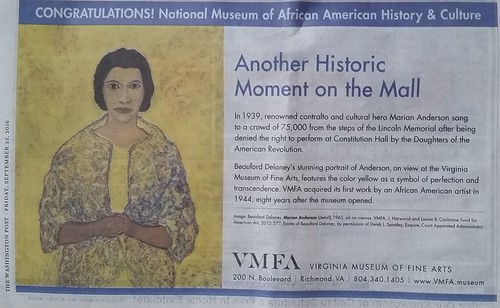6Ps and cultural planning and the failure to create a network of African American historic sites across the DMV
(6Ps = prior planning prevents p*** poor performance)
Image from "The Smithsonian's NMAAHC Takes Shape on the National Mall," Architect Magazine.
This piece is in response to the Washington Business Journal story, "What the new African-American Museum means for its small peers," and the opening of the new Smithsonian National Museum of African American History and Culture ("Historic bell will ring for 'justice' at opening of new African American History Museum," USA Today).
When I was working with some people in Cambridge, Maryland, in response to a point about better harvesting of African American cultural history as part of cultural heritage tourism, I said that African-American history would be better marketed if the area's tourism departments created a multi-state African-American heritage site network.
The model would be how a multi-state "Civil War Trail" has been created by joint efforts by the states of Maryland, North Carolina, Tennessee, Virginia, and West Virginia.
In advance of the opening of the new Museum, it's a shame that the area's tourism authorities didn't come together and create a comparable heritage interpretation system, as a way to co-market their museums and sites and complement the national museum.
-- African American Heritage and Ethnography, National Park Service, Park Ethnography Program
The many hundreds if not thousands of sites in such a trail network could include those mentioned in the WBJ article including the Alexandria Black History Museum, Frederick Douglass National Historic Site, the Carter G. Woodson House in Shaw, the Martin Luther King Jr. Memorial near the National Mall, the African American Civil War Memorial and Museum and the Howard Theatre, in the U Street Historic District, and Smithsonian’s Anacostia Community Museum.
... as well as many other sites and facilities throughout the multi-state region including examples of segregated schools, Howard University, the Reginald F. Lewis African American Museum in Baltimore, the Harriet Tubman Museum and Educational Center in Dorchester County, Maryland and the Harriet Tubman Underground Railroad Scenic Byway, as well as the sites on the DC African American Heritage Trail and the Richmond Slave Trail in Virginia.
That way, the Smithsonian National Museum of African American History and Culture contributes more broadly to heritage interpretation and the number of people visiting these sites, rather than diverting people from those sites to the Museum.
Ad published in the Express, by the Virginia Museum of Fine Arts, Richmond, congratulating the NMAAHC on its opening, and calling attention to a work in its collection, a portrait of Marion Anderson by Beauford Delaney.

Labels: cultural heritage/tourism, cultural planning, public history, travel planning/tourism






2 Comments:
speaking of not systematically identifying and working to save historic resources:
https://www.washingtonpost.com/lifestyle/food/mlks-booth-at-his-go-to-barbecue-joint-became-a-memorial-then-it-disappeared/2016/09/19/d0ab667a-79e6-11e6-ac8e-cf8e0dd91dc7_story.html
://www.washingtonpost.com/lifestyle/food/they-fed-the-civil-rights-movement-now-are-black-owned-barbecue-joints-dying/2016/02/22/382079de-d506-11e5-be55-2cc3c1e4b76b_story.html
The irony of course is that wrt Aleck's you'd expect that the City of Atlanta, given its history and the prominence of black elected officials, would have addressed this "more" and better than other cities with less visible and prominent heritage.
Connecticut Freedom Trail is a statewide African-American history trail.
http://www.ctfreedomtrail.org/
http://www.ctfreedomtrail.org/data/files/resource-library/FreedomTrail_Brochure_final.pdf
Post a Comment
<< Home